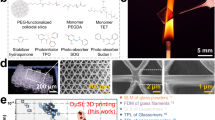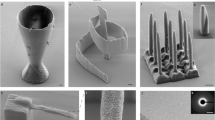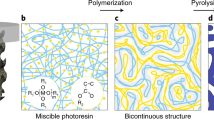Abstract
Glass is one of the most important high-performance materials used for scientific research, in industry and in society, mainly owing to its unmatched optical transparency, outstanding mechanical, chemical and thermal resistance as well as its thermal and electrical insulating properties1,2,3. However, glasses and especially high-purity glasses such as fused silica glass are notoriously difficult to shape, requiring high-temperature melting and casting processes for macroscopic objects or hazardous chemicals for microscopic features3,4. These drawbacks have made glasses inaccessible to modern manufacturing technologies such as three-dimensional printing (3D printing). Using a casting nanocomposite5, here we create transparent fused silica glass components using stereolithography 3D printers at resolutions of a few tens of micrometres. The process uses a photocurable silica nanocomposite that is 3D printed and converted to high-quality fused silica glass via heat treatment. The printed fused silica glass is non-porous, with the optical transparency of commercial fused silica glass, and has a smooth surface with a roughness of a few nanometres. By doping with metal salts, coloured glasses can be created. This work widens the choice of materials for 3D printing, enabling the creation of arbitrary macro- and microstructures in fused silica glass for many applications in both industry and academia.
This is a preview of subscription content, access via your institution
Access options
Access Nature and 54 other Nature Portfolio journals
Get Nature+, our best-value online-access subscription
$29.99 / 30 days
cancel any time
Subscribe to this journal
Receive 51 print issues and online access
$199.00 per year
only $3.90 per issue
Buy this article
- Purchase on Springer Link
- Instant access to full article PDF
Prices may be subject to local taxes which are calculated during checkout




Similar content being viewed by others
References
Hench, L. L., Day, D. E., Höland, W. & Rheinberger, V. M. Glass and medicine. Int. J. Appl. Glass Sci. 1, 104–117 (2010)
Ikushima, A., Fujiwara, T. & Saito, K. Silica glass: a material for photonics. J. Appl. Phys. 88, 1201–1213 (2000)
Bansal, N. P. & Doremus, R. H. Handbook of Glass Properties 680 (Elsevier, 2013)
Hülsenberg, D ., Harnisch, A. & Bismarck, A. Microstructuring of Glasses 1st edn, Vol. 87, 323 (Springer, 2005)
Kotz, F. et al. Liquid glass: a facile soft replication method for structuring glass. Adv. Mater. 28, 4646–4650 (2016)
Klein, J. et al. Additive manufacturing of optically transparent glass. 3D Print. Additive Manuf. 2, 92–105 (2015)
Luo, J . et al. in Proc. Conf. SPIE LASE 97380Y–97380Y–9, http://dx.doi.org/10.1117/12.2218137 (International Society for Optics and Photonics, 2016)
Luo, J., Pan, H. & Kinzel, E. C. Additive manufacturing of glass. J. Manuf. Sci. Eng. 136, 061024 (2014)
Klein, S ., Simske S ., Parraman C ., Walters P ., Huson D. & Hoskins S. 3D Printing of Transparent Glass Technical Report HPL-2012-198, http://www.hpl.hp.com/techreports/2012/HPL-2012-198.pdf (Hewlett Packard Labs, 2012)
Marchelli, G., Prabhakar, R., Storti, D. & Ganter, M. The guide to glass 3D printing: developments, methods, diagnostics and results. Rapid Prototyping J. 17, 187–194 (2011)
Fateri, M. & Gebhardt, A. Selective laser melting of soda-lime glass powder. Int. J. Appl. Ceram. Technol. 12, 53–61 (2015)
Klocke, F., McClung, A. & Ader, C. in Proc. Solid Freeform Fabrication Symp. 214–219, https://sffsymposium.engr.utexas.edu/Manuscripts/2004/2004-21-Klocke.pdf (2004)
Shepherd, R. F. et al. Stop-flow lithography of colloidal, glass, and silicon microcomponents. Adv. Mater. 20, 4734–4739 (2008)
Lin, J. et al. On-chip three-dimensional high-Q microcavities fabricated by femtosecond laser direct writing. Opt. Express 20, 10212–10217 (2012)
Raghavan, S. R., Walls, H. & Khan, S. A. Rheology of silica dispersions in organic liquids: new evidence for solvation forces dictated by hydrogen bonding. Langmuir 16, 7920–7930 (2000)
Sun, C. & Zhang, X. The influences of the material properties on ceramic micro-stereolithography. Sens. Actuators A 101, 364–370 (2002)
Souder, W. H. & Hidnert, P. Measurements on the Thermal Expansion of Fused Silica 3 (Government Printing Office, 1926)
Waldbaur, A., Carneiro, B., Hettich, P., Wilhelm, E. & Rapp, B. Computer-aided microfluidics (CAMF): from digital 3D-CAD models to physical structures within a day. Microfluid. Nanofluid. 15, 625–635 (2013)
Clasen, R. Preparation of coloured silica glasses made by sintering of particulate gels. Glastechnische Berichte 66, 299–304 (1993)
Schultz, P. C. Optical absorption of the transition elements in vitreous silica. J. Am. Ceram. Soc. 57, 309–313 (1974)
Kozuka, H. & Sakka, S. Preparation of gold colloid-dispersed silica-coating films by the sol-gel method. Chem. Mater. 5, 222–228 (1993)
Seah, M., Gilmore, I. & Beamson, G. XPS: binding energy calibration of electron spectrometers 5—re-evaluation of the reference energies. Surf. Interf. Anal. 26, 642–649 (1998)
Moulder, J. F ., Stickle, W. F ., Sobol, P. E & Bomben, K. D. Handbook of X-ray Photoelectron Spectroscopy: a Reference Book of Standard Spectra for Identification and Interpretation of XPS Data 238 (Physical Electronics Eden Prairie, 1995)
Acknowledgements
This work was funded in part by the German Federal Ministry of Education and Research (BMBF), “Fluoropor” (grant number 03X5527) and “Molecular Interaction Engineering: From Nature’s Toolbox to Hybrid Technical Systems” (grant number 031A095C). We thank S. Wagner for helping with the photographs and R. Thelen for atomic force microscope measurements. We thank the Institute of Applied Materials (IAM-WPT) for helping with the Supplementary Video. This work was partly carried out with the support of the Karlsruhe Nano Micro Facility (www.kit.edu/knmf), a Helmholtz Research Infrastructure at KIT. We thank BASF and Evonik for providing chemicals.
Author information
Authors and Affiliations
Contributions
F.K. and B.E.R. conceived the idea. F.K. designed the experiments, synthesized the material and performed the stereolithography processes. K.A. performed the microlithography process. W.B. performed X-ray diffraction and thermal gravimetric analysis measurements. C.R. performed white-light interferometry measurements. N.K., T.M.N. and K.S. performed scanning electron microscopy measurements. D.H. performed ultraviolet–visible measurements. F.K. wrote the manuscript and all authors contributed to the writing of the manuscript.
Corresponding author
Ethics declarations
Competing interests
The authors declare no competing financial interests.
Additional information
Reviewer Information Nature thanks J. Smay and the other anonymous reviewer(s) for their contribution to the peer review of this work.
Publisher's note: Springer Nature remains neutral with regard to jurisdictional claims in published maps and institutional affiliations.
Extended data figures and tables
Extended Data Figure 1 Characterization of the nanocomposite processing.
a, Thermal gravimetric analysis of the cured nanocomposite used for stereolithography. The sample had a solid loading of 37.5 vol% SiO2. b, Corresponding heating programme for thermal debinding (I) and sintering (II) used for the composite shaped using stereolithography. c, Stereolithography cure depth (depth of a voxel upon exposure, corresponding to the penetration of the polymerization front during exposure) versus the laser power. The nanocomposites are highly stable and can be used for weeks with the same polymerization parameters.
Extended Data Figure 2 Material and surface characterization of sintered glass.
a, X-ray photoelectron spectroscopy narrow scans of elemental lines of printed and sintered glass compared to commercial fused silica glass. All spectra show virtually no difference between sintered fused silica glass and commercial fused silica glass. b, X-ray diffraction measurement shows that no devitrification occurs during the sintering process. Devitrification would present in the form of narrow peaks and spikes in the spectrum. c, Fourier transform infrared (FTIR) measurements of sintered glass compared to commercial fused silica glass.
Supplementary information
Supplementary Information
This file contains Supplementary Text. (PDF 110 kb)
Three-dimensional printing of glass
The video gives a short introduction into the printing process of the nanocomposite, the thermal debinding and the sintering process. (MP4 18333 kb)
Rights and permissions
About this article
Cite this article
Kotz, F., Arnold, K., Bauer, W. et al. Three-dimensional printing of transparent fused silica glass. Nature 544, 337–339 (2017). https://doi.org/10.1038/nature22061
Received:
Accepted:
Published:
Issue Date:
DOI: https://doi.org/10.1038/nature22061
This article is cited by
-
One-photon three-dimensional printed fused silica glass with sub-micron features
Nature Communications (2024)
-
Temperature-driven controllable deformation in 4D printing through programmable heterogeneous laminated bilayer structure
The International Journal of Advanced Manufacturing Technology (2024)
-
A simulation model of selective laser melting (SLM) of glass silica monolayer
The International Journal of Advanced Manufacturing Technology (2024)
-
Advances in industry 4.0: from intelligentization to the industrial metaverse
International Journal on Interactive Design and Manufacturing (IJIDeM) (2024)
-
Exploring the advantages and applications of nanocomposites produced via vat photopolymerization in additive manufacturing: A review
Advanced Composites and Hybrid Materials (2024)
Comments
By submitting a comment you agree to abide by our Terms and Community Guidelines. If you find something abusive or that does not comply with our terms or guidelines please flag it as inappropriate.



